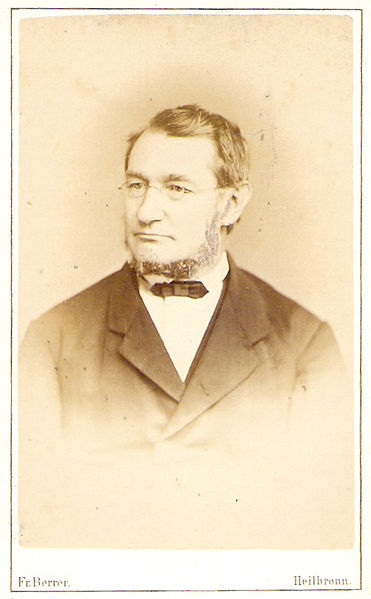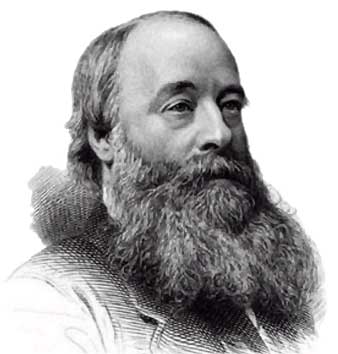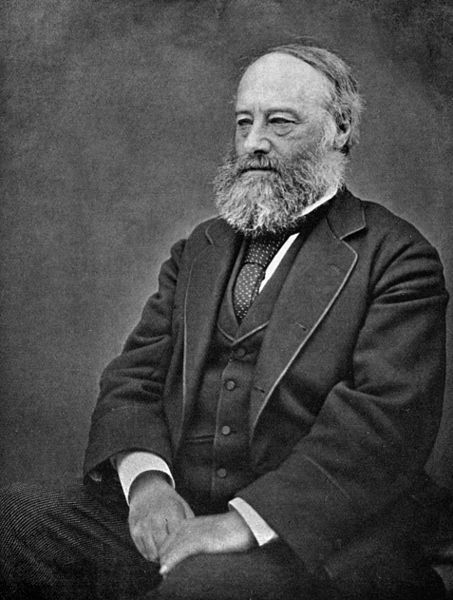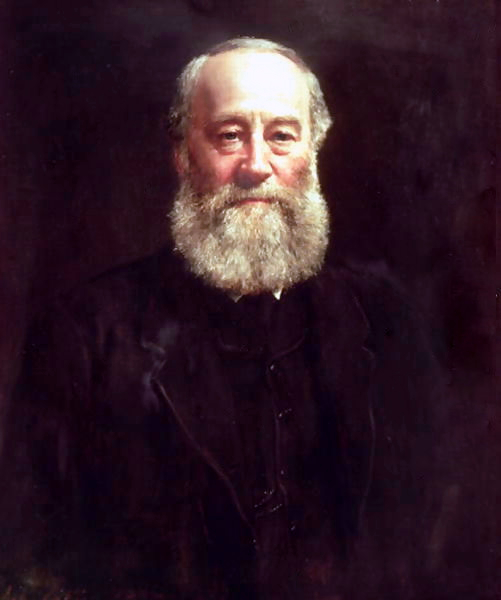<Back to Index>
- Physicist and Physician Julius Robert von Mayer, 1814
- Physicist and Brewer James Prescott Joule, 1818
PAGE SPONSOR

Julius Robert von Mayer (November 25, 1814 – March 20, 1878) was a German physician and physicist and one of the founders of thermodynamics. He is best known for enunciating in 1841 one of the original statements of the conservation of energy or what is now known as one of the first versions of the first law of thermodynamics, namely that "energy can be neither created nor destroyed". In 1842, Mayer described the vital chemical process now referred to as oxidation as the primary source of energy for any living creature. His achievements were overlooked and priority for the discovery of the mechanical equivalent of heat was attributed to James Joule in the following year. He also proposed that plants convert light into chemical energy.
Von Mayer was born on November 25, 1814 in Heilbronn, Württemberg (Baden - Württemberg, modern day Germany), the son of a pharmacist. He grew up in Heilbronn. After completing his Abitur, he studied medicine at the University of Tübingen, where he was a member of the Corps Guestphalia, a German Student Corps. During 1838 he attained his doctorate as well as passing the Staatsexamen. After a stay in Paris (1839 - 40) he left as a ship's physician on a Dutch three - mast sailing ship for a journey to Jakarta.
Although he had hardly been interested before this journey in physical phenomena, his observation that storm - whipped waves are warmer than the calm sea started him thinking about the laws of nature, in particular about the physical phenomenon of warmth and the question: whether the directly developed heat alone or whether the sum of the amounts of heat developed in direct and indirect ways contributes to the temperature. After his return in February 1841 Mayer dedicated his efforts to solve this problem.
In 1841 he settled in Heilbronn and married.
Even as a young child, Mayer showed an intense interest with various mechanical mechanisms. He was a young man who performed various experiments of the physical and chemical variety. In fact, one of his favorite hobbies was creating various types of electrical devices and air pumps. It was obvious that he was intelligent. Hence, Mayer attended Eberhard - Karls University in May 1832. He studied medicine during his time there.
In 1837, he and some of his friends were arrested for wearing the colors of a forbidden organization. The consequences for this arrest included a one year expulsion from the college and a brief period of incarceration. This diversion sent Mayer traveling to Switzerland, France and the Dutch East Indies. Mayer drew some additional interest in mathematics and engineering from his friend Carl Baur through private tutoring. In 1841, Mayer returned to Heilbronn to practice medicine, but physics became his new passion.
In June 1841, he completed his first scientific paper entitled "On the Quantitative and Qualitative Determination of Forces". It was largely ignored by other professionals in the area. Then, Mayer became interested in the area of heat and its motion. He presented a value in numerical terms for the mechanical equivalent of heat. He also was the first person to describe the vital chemical process now referred to as oxidation as the primary source of energy for any living creature.
In 1848 he calculated that in the absence of a source of energy the Sun would cool down in only 5000 years, and he suggested that the impact of meteorites kept it hot.
Since he was not taken seriously at the time, his achievements were overlooked and credit was given to James Joule. Mayer almost committed suicide after he discovered this fact. He spent some time in mental institutions to recover from this and the loss of some of his children. Several of his papers were published due to the advanced nature of the physics and chemistry. He was awarded an honorary doctorate in 1859 by the philosophical faculty at the University of Tübingen. His overlooked work was revived in 1862 by fellow physicist John Tyndall in a lecture at the London Royal Institution. In July 1867, Mayer published "Die Mechanik der Wärme." This publication dealt with the mechanics of heat and its motion. In November 1867, Mayer was awarded personal nobility (von Mayer) which is the German equivalent of a British knighthood. Julius Robert von Mayer died from tuberculosis on March 20, 1878 in Germany.
Mayer was the first person to state the law of the conservation of energy, one of the most fundamental tenets of modern day physics. The law of the conservation of energy states that the total mechanical energy of a system remains constant in any isolated system of objects that interact with each other only by way of forces that are conservative.
Mayer's first attempt at stating the conservation of energy was a paper he sent to Johann Christian Poggendorff's Annalen der Physik, in which he postulated a conservation of force (Erhaltungssatz der Kraft). However, owing to Mayer's lack of advanced training in physics, it contained some fundamental mistakes and was not published. Mayer continued to pursue the idea steadfastly and argued with the Tübingen physics professor Johann Gottlieb Nörremberg, who rejected his hypothesis. Nörremberg did, however, give Mayer a number of valuable suggestions on how the idea could be examined experimentally; for example, if kinetic energy transforms into heat energy, water should be warmed by vibration.
Mayer not only performed this demonstration, but determined also the quantitative factor of the transformation, calculating the mechanical equivalent of heat. The result of his investigations was published 1842 in the May edition of Justus von Liebig's Annalen der Chemie und Pharmacie. In his booklet Die organische Bewegung im Zusammenhang mit dem Stoffwechsel (The Organic Movement in Connection with the Metabolism, 1845) he specified the numerical value of the mechanical equivalent of heat: at first as 365 kgf·m/kcal, later as 425 kgf·m/kcal; the modern values are 4.184 kJ/kcal (426.6 kgf·m/kcal) for the thermochemical calorie and 4.1868 kJ/kcal (426.9 kgf·m/kcal) for the international steam table calorie.
This relation implies that, although work and heat are different forms of energy, they can be transformed into one another. This law is called the first law of the caloric theory and led to the formulation of the general principle of conservation of energy, definitively stated by Hermann von Helmholtz in 1847.
Mayer also derived that for an ideal gas
![]() ,
,
where CP,m is the specific heat at constant pressure, CV,m is the specific heat at constant volume and R is the gas constant.
Mayer was aware of the importance of his discovery, but his inability to express himself scientifically led to degrading speculation and resistance from the scientific establishment. Contemporary physicists rejected his principle of conservation of energy, and even acclaimed physicists Hermann von Helmholtz and James Prescott Joule viewed his ideas with hostility. The former doubted Mayer's qualifications in physical questions, and a bitter dispute over priority developed with the latter.
In 1848 two of his children died rapidly in succession, and Mayer's mental health deteriorated. He attempted suicide on May 18, 1850 and was committed to a mental institution. After he was released, he was a broken man and only timidly re-entered public life in 1860. However, in the meantime, his scientific fame had grown and he received a late appreciation of his achievement, although perhaps at a stage where he was no longer able to enjoy it.
He continued to work vigorously as a physician until his death.



James Prescott Joule FRS (24 December 1818 – 11 October 1889) was an English physicist and brewer, born in Salford, Lancashire. Joule studied the nature of heat, and discovered its relationship to mechanical work. This led to the theory of conservation of energy, which led to the development of the first law of thermodynamics. The SI derived unit of energy, the joule, is named after him. He worked with Lord Kelvin to develop the absolute scale of temperature, made observations on magnetostriction, and found the relationship between the current through resistance and the heat dissipated, now one of the two laws called Joule's law.
The son of Benjamin Joule (1784 – 1858), a wealthy brewer, and Alice Prescott Joule, James Prescott Joule was born in the house adjoining the Joule Brewery in New Bailey Street, Salford, 24 December 1818. James was tutored at the family home 'Broomhill', Pendlebury, near Salford, until 1834 when he was sent with his elder brother Benjamin, to study with John Dalton at the Manchester Literary and Philosophical Society. The pair only received two years' education in arithmetic and geometry before Dalton was forced to retire owing to a stroke. However, Dalton's influence made a lasting impression as did that of his associates, chemist William Henry and Manchester engineers Peter Ewart and Eaton Hodgkinson. Joule was subsequently tutored by John Davies. Fascinated by electricity, he and his brother experimented by giving electric shocks to each other and to the family's servants.
Joule became a manager of the brewery and took an active role until the sale of the business in 1854. Science was a hobby but he soon started to investigate the feasibility of replacing the brewery's steam engines with the newly invented electric motor. In 1838, his first scientific papers on electricity were contributed to Annals of Electricity, the scientific journal founded and operated by Davies's colleague William Sturgeon. He formulated Joule's laws in 1840 and hoped to impress the Royal Society but found, not for the last time, that he was perceived as a mere provincial dilettante. When Sturgeon moved to Manchester in 1840, Joule and he became the nucleus of a circle of the city's intellectuals. The pair shared similar sympathies that science and theology could and should be integrated. Joule went on to lecture at Sturgeon's Royal Victoria Gallery of Practical Science.
He went on to realize that burning a pound of coal in a steam engine produced five times as much duty as a pound of zinc consumed in a Grove cell, an early electric battery. Joule's common standard of "economical duty" was the ability to raise one pound by a height of one foot, the foot - pound.
Joule was influenced by the thinking of Franz Aepinus and tried to explain the phenomena of electricity and magnetism in terms of atoms surrounded by a "calorific ether in a state of vibration".
However, Joule's interest diverted from the narrow financial question to that of how much work could be extracted from a given source, leading him to speculate about the convertibility of energy. In 1843 he published results of experiments showing that the heating effect he had quantified in 1841 was due to generation of heat in the conductor and not its transfer from another part of the equipment. This was a direct challenge to the caloric theory which held that heat could neither be created nor destroyed. Caloric theory had dominated thinking in the science of heat since it was introduced by Antoine Lavoisier in 1783. Lavoisier's prestige and the practical success of Sadi Carnot's caloric theory of the heat engine since 1824 ensured that the young Joule, working outside either academia or the engineering profession, had a difficult road ahead. Supporters of the caloric theory readily pointed to the symmetry of the Peltier - Seebeck effect to claim that heat and current were convertible, at least approximately, by a reversible process.
Joule wrote in his 1845 paper:
... the mechanical power exerted in turning a magneto - electric machine is converted into the heat evolved by the passage of the currents of induction through its coils; and, on the other hand, that the motive power of the electro - magnetic engine is obtained at the expense of the heat due to the chemical reactions of the battery by which it is worked.
Joule here adopts the language of vis viva (energy), possibly because Hodgkinson had read a review of Ewart's On the measure of moving force to the Literary and Philosophical Society in April 1844.
Further experiments and measurements by Joule led him to estimate the mechanical equivalent of heat as 838 ft · lbf of work to raise the temperature of a pound of water by one degree Fahrenheit. He announced his results at a meeting of the chemical section of the British Association for the Advancement of Science in Cork in 1843 and was met by silence.
Joule was undaunted and started to seek a purely mechanical demonstration of the conversion of work into heat. By forcing water through a perforated cylinder, he was able to measure the slight viscous heating of the fluid. He obtained a mechanical equivalent of 770 ft·lbf/Btu (4.14 J/cal). The fact that the values obtained both by electrical and purely mechanical means were in agreement to at least one order of magnitude was, to Joule, compelling evidence of the reality of the convertibility of work into heat.
Joule now tried a third route. He measured the heat generated against the work done in compressing a gas. He obtained a mechanical equivalent of 823 ft·lbf/Btu (4.43 J/cal). In many ways, this experiment offered the easiest target for Joule's critics but Joule disposed of the anticipated objections by clever experimentation. However, his paper was rejected by the Royal Society and he had to be content with publishing in the Philosophical Magazine. In the paper he was forthright in his rejection of the caloric reasoning of Carnot and Émile Clapeyron, but his theological motivations also became evident:
I conceive that this theory ... is opposed to the recognised principles of philosophy because it leads to the conclusion that vis viva may be destroyed by an improper disposition of the apparatus: Thus Mr Clapeyron draws the inference that 'the temperature of the fire being 1000 °C to 2000 °C higher than that of the boiler there is an enormous loss of vis viva in the passage of the heat from the furnace to the boiler.' Believing that the power to destroy belongs to the Creator alone I affirm ... that any theory which, when carried out, demands the annihilation of force, is necessarily erroneous.
In 1845, Joule read his paper On the mechanical equivalent of heat to the British Association meeting in Cambridge. In this work, he reported his best known experiment, involving the use of a falling weight, in which gravity does the mechanical work, to spin a paddle - wheel in an insulated barrel of water which increased the temperature. He now estimated a mechanical equivalent of 819 ft·lbf/Btu (4.41 J/cal).
In 1850, Joule published a refined measurement of 772.692 ft·lbf/Btu (4.159 J/cal), closer to twentieth century estimates.
Much of the initial resistance to Joule's work stemmed from its dependence upon extremely precise measurements. He claimed to be able to measure temperatures to within 1⁄200 of a degree Fahrenheit (3 mK). Such precision was certainly uncommon in contemporary experimental physics but his doubters may have neglected his experience in the art of brewing and his access to its practical technologies. He was also ably supported by scientific instrument maker John Benjamin Dancer.
However, in Germany, Hermann Helmholtz became aware both of Joule's work and the similar 1842 work of Julius Robert von Mayer. Though both men had been neglected since their respective publications, Helmholtz's definitive 1847 declaration of the conservation of energy credited them both.
Also in 1847, another of Joule's presentations at the British Association in Oxford was attended by George Gabriel Stokes, Michael Faraday and the precocious and maverick William Thomson, later to become Lord Kelvin, who had just been appointed professor of natural philosophy at the University of Glasgow. Stokes was "inclined to be a Joulite" and Faraday was "much struck with it" though he harbored doubts. Thomson was intrigued but skeptical.
Unanticipated, Thomson and Joule met later that year in Chamonix. Joule married Amelia Grimes on 18 August and the couple went on honeymoon. Marital enthusiasm notwithstanding, Joule and Thomson arranged to attempt an experiment a few days later to measure the temperature difference between the top and bottom of the Cascade de Sallanches waterfall, though this subsequently proved impractical.
Though Thomson felt that Joule's results demanded theoretical explanation, he retreated into a spirited defense of the Carnot - Clapeyron school. In his 1848 account of absolute temperature, Thomson wrote that "the conversion of heat (or caloric) into mechanical effect is probably impossible, certainly undiscovered" – but a footnote signaled his first doubts about the caloric theory, referring to Joule's "very remarkable discoveries". Surprisingly, Thomson did not send Joule a copy of his paper but when Joule eventually read it he wrote to Thomson on 6 October, claiming that his studies had demonstrated conversion of heat into work but that he was planning further experiments. Thomson replied on the 27th, revealing that he was planning his own experiments and hoping for a reconciliation of their two views. Though Thomson conducted no new experiments, over the next two years he became increasingly dissatisfied with Carnot's theory and convinced of Joule's. In his 1851 paper, Thomson was willing to go no further than a compromise and declared "the whole theory of the motive power of heat is founded on ... two ... propositions, due respectively to Joule, and to Carnot and Clausius".
As soon as Joule read the paper he wrote to Thomson with his comments and questions. Thus began a fruitful, though largely epistolary, collaboration between the two men, Joule conducting experiments, Thomson analyzing the results and suggesting further experiments. The collaboration lasted from 1852 to 1856, its discoveries including the Joule - Thomson effect, and the published results did much to bring about general acceptance of Joule's work and the kinetic theory.
Kinetics is the science of motion. Joule was a pupil of Dalton and it is no surprise that he had learned a firm belief in the atomic theory, even though there were many scientists of his time who were still skeptical. He had also been one of the few people receptive to the neglected work of John Herapath on the kinetic theory of gases. He was further profoundly influenced by Peter Ewart's 1813 paper On the measure of moving force.
Joule perceived the relationship between his discoveries and the kinetic theory of heat. His laboratory notebooks reveal that he believed heat to be a form of rotational, rather than translational motion.
Joule could not resist finding antecedents of his views in Francis Bacon, Sir Isaac Newton, John Locke, Benjamin Thompson (Count Rumford) and Sir Humphry Davy. Though such views are justified, Joule went on to estimate a value for the mechanical equivalent of heat of 1034 foot-pound from Rumford's publications. Some modern writers have criticized this approach on the grounds that Rumford's experiments in no way represented systematic quantitative measurements. In one of his personal notes, Joule contends that Mayer's measurement was no more accurate than Rumford's, perhaps in the hope that Mayer had not anticipated his own work. Joule is attributed with explaining the Green Flash phenomenon in a letter to the Manchester Literary and Philosophical Society in 1869.
Joule died at home in Sale and is buried in Brooklands cemetery there. The gravestone is inscribed with the number "772.55", his climacteric 1878 measurement of the mechanical equivalent of heat, in which he found that this amount of foot - pounds of work must be expended at sea level to raise the temperature of one pound of water from 60 to 61 F. There is also a quotation from the Gospel of John, "I must work the works of him that sent me, while it is day: the night cometh, when no man can work" (9:4). The Wetherspoon's public house in Sale, the town of his death, maybe named after him, but may also likely to be linked with the name of the family brewery.
- Fellow of the Royal Society, (1850);
- Royal Medal, (1852);
- Copley Medal (1870);
- President of Manchester Literary and Philosophical Society, (1860);
- President of the British Association for the Advancement of Science, (1872, 1887);
- Honorary Membership of the Institution of Engineers and Shipbuilders in Scotland, (1857);
- Honorary degrees:
- LL.D., Trinity College Dublin, (1857);
- DCL, University of Oxford, (1860);
- LL.D., University of Edinburgh, (1871).
- He received a civil list pension of £200 per annum in 1878 for services to science;
- Albert Medal of the Royal Society of Arts, (1880).
- There is a memorial to Joule in the north choir aisle of Westminster Abbey, though he is not buried there, contrary to what some biographies state.
- A statue by Alfred Gilbert, stands in Manchester Town Hall, opposite that of Dalton.